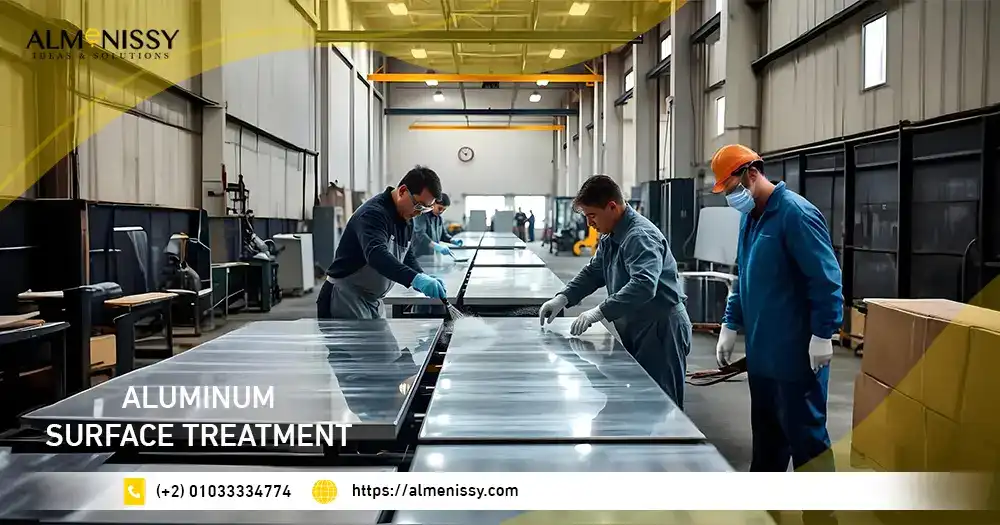With the increasing demand for high-quality products and superior performance, aluminum surface treatment has become a vital process in many industries. Surface treatment techniques are used to enhance the properties of aluminum, such as its corrosion resistance, improve its appearance, and increase its durability.
Whether through anodizing, coating, or polishing processes, these treatments play a critical role in ensuring that aluminum meets the stringent standards of various applications, from aerospace and automotive to construction and interior design. In this context, we review the latest innovations and technologies used in aluminum surface treatment, and how these processes contribute to achieving optimal performance and sustainability.
Table of Contents
What Is Aluminum Surface Treatment?
Aluminum surface treatment is a group of processes and techniques designed to enhance the properties of aluminum and expand it in various applications. This treatment typically involves treating the surface to remove impurities and improve its appearance, in addition to enhancing the mechanical and chemical properties of the material.
The most common surface treatment techniques include anodizing, which adds a thin, protective oxide layer to the surface, increasing its resistance to corrosion and give aluminum an attractive appearance. Coating and Polishing processes are also used to add aesthetic touches and improve performance.
These treatments are essential in many industries, such as aerospace, automotive, and construction, as they contribute to achieving high levels of quality and durability, and ensure that aluminum remains an ideal choice for various projects.
What Is The Pre Treatment Process For Aluminum?
The pretreatment process for aluminum is an essential step that precedes any type of surface treatment, such as anodizing or painting. This process aims to clean the aluminum surface and prepare it perfectly for subsequent treatments. Pretreatment involves several stages, usually starting with removing dirt and impurities from the surface, which can include manufacturing oils, material residues, and oxides.
Techniques such as hot water washing, and the use of special chemicals, such as alkaline or acidic solutions, are used to ensure a completely clean surface. After that, processes such as sandblasting or water blasting may be used to remove any surface defects and achieve an ideal smoothness.
These steps are vital because they directly affect the adhesion of materials used in subsequent treatments, such as painting or anodizing. Ultimately, pretreatment contributes significantly to improving the overall performance of aluminum and ensuring the quality of the final processing, which increases the durability of the product and enhances its corrosion resistance.
How To Treat Aluminum?
Aluminum surface treatment is a multi-step process that aims to improve its surface properties and make it more suitable for various uses. The process usually begins with pretreatment, which involves cleaning the surface to remove dirt, oils, and impurities using chemicals or mechanical methods such as sandblasting. After that, one of several main treatment methods can be chosen, such as anodizing or painting.
Anodizing is an electrical process that creates a thin oxide layer on the surface of aluminum, which increases its resistance to corrosion and improves its appearance. This process is widely used in applications that require high durability, such as in the aircraft and automotive industries.
Painting is another option, where a layer of paint is applied to the surface. The paint can be colored or clear, and works to protect the aluminum from environmental factors and corrosion. Common painting methods include powder coating and liquid coating, both of which provide scratch and rust resistant layers.
Polishing is also a part of aluminum treatment, aiming to improve the gloss and aesthetic appearance of the surface. This is done using chemicals or abrasives to achieve a smooth and shiny surface.
What Is The Best Surface Coating For Aluminum?
When talking about the best aluminum surface treatment, powder coating is one of the most popular and effective options. This process involves applying a special powder to the aluminum surface using an electrical charge, which ensures excellent adhesion of the paint. Powder coating offers a wide range of colors and patterns, in addition to its high resistance to scratches and corrosion.
Liquid coating is another option, allowing for the application of multiple layers and contributing to a smooth and attractive finish. On the other hand, anodizing is also used as an effective surface treatment method, adding an oxide layer that protects the aluminum from environmental factors and enhances its durability. In general, choosing the best coating depends on the intended use of the aluminum, but powder coating remains the preferred choice for many industries due to its superior performance and appearance features.
What Is The Process Of Aluminum Treatment
The aluminum surface treatment process involves several steps aimed at improving its physical and chemical properties. The process typically begins with a pre-treatment that involves cleaning the surface to remove dirt and impurities using chemical solutions or mechanical
methods such as sandblasting.
Next, treatment techniques such as anodizing, which enhances the aluminum’s resistance to corrosion by forming a protective oxide layer, or powder coating, which provides a wide range of colors and aesthetic finishes are applied. Processes such as polishing can also be used to improve the overall appearance. All of these steps are aimed at ensuring that the aluminum meets the high requirements for performance and quality in various applications.
What Is The Difference Between Surface Treatment And Coating?
Aluminum surface treatment differs from coating in that surface treatment includes a range of processes that enhance the properties of aluminum, such as corrosion resistance and strength, while coating specifically refers to the application of an outer layer to a surface.
Aluminum surface treatment focuses on altering the surface’s inherent physical characteristics, such as anodizing or blasting, while coating is added for protection or to improve appearance. In general, surface treatment can be a preparatory step before coating to ensure good adhesion and high efficiency.
Conclusion
In conclusion, according to Alminssy Company, aluminum surface treatment is an essential element in enhancing the quality and efficiency of this lightweight and flexible metal. Through techniques such as anodizing and coating, aluminum’s resistance to corrosion can be improved, ensuring longer life and better performance in a variety of applications.
These processes also contribute to aesthetic touches, making aluminum a preferred choice in industrial and architectural design. As innovations in this field continue, we can expect further developments that will enhance aluminum’s capabilities and open up new horizons for its uses.
FAQ
What Is The Best Treatment For Aluminum?
The best treatment for aluminum depends on the intended application. However, anodizing and powder coating are considered the most effective methods, as they enhance corrosion resistance and provide an attractive appearance.
What Is Solution Treatment Of Aluminum?
Solution treatment of aluminum is a thermal process used to improve its mechanical properties. It involves heating aluminum to a specific temperature and then cooling it rapidly, which helps distribute the alloying elements evenly within the crystal lattice.


